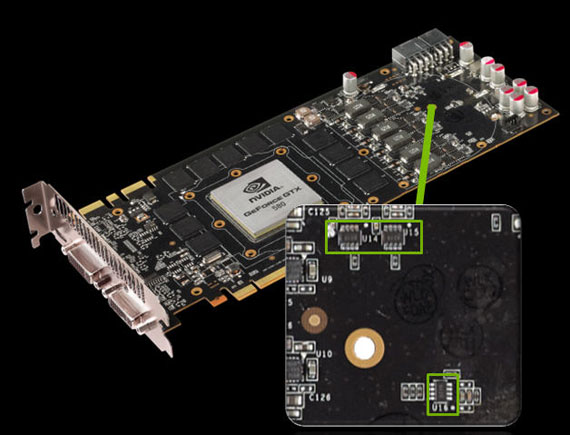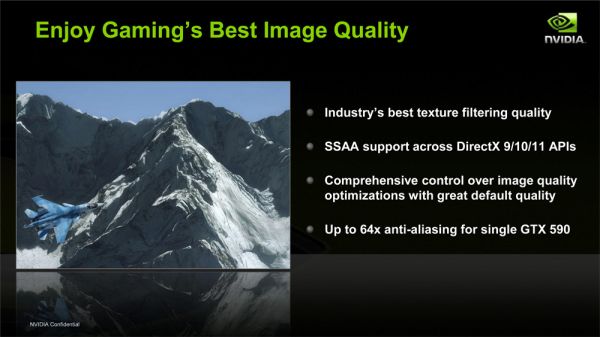NVIDIA’s GeForce GTX 590: Duking It Out For The Single Card King
by Ryan Smith on March 24, 2011 9:00 AM ESTOCP Refined, A Word On Marketing, & The Test
As you may recall from our GTX 580 launch article, NVIDIA added a rudimentary OverCurrent Protection (OCP) feature to the GTX 500 series. At the time of the GTX 580 launch, OCP would clamp down on Furmark and OCCT keep those programs from performing at full speed, as the load they generated was so high that it risked damaging the card. As a matter of principle we have been disabling OCP in all of our tests up until now as OCP was only targeting Furmark and OCCT, meaning it didn’t provide any real protection for the card in any other situations. Our advice to NVIDIA at the time was to expand it to cover the hardware at a generic level, similar to how AMD’s PowerTune operates.

We’re glad to report that NVIDIA has taken up at least some of our advice, and that OCP is taking its first step forward since then. Starting with the ForceWare 267 series drivers, NVIDIA is now using OCP at all times, meaning OCP now protects against any possible program that would generate an excessive load (as defined by NVIDIA), and not just Furmark and OCCT. At this time there’s definitely still a driver component involved as NVIDIA still throttles Furmark and OCCT right off the bat, but everything else seems to be covered by their generic detection methods.
At this point our biggest complaint is that OCP’s operation is still not transparent to the end user. If you trigger it you have no way of knowing unless you know how the game/application should already be performing. NVIDIA tells us that at some point this will be exposed through NVIDIA’s driver API, but today is not that day. Along those lines, at least in the case of Furmark and OCCT OCP still throttles to an excessive degree—whereas AMD gets this right and caps anything and everything at the PowerTune limit, we still see OCP heavily clamp these programs to the point that our GTX 590 draws 100W more under games than it does under Furmark. Clamping down on a program to bring power consumption down to safe levels is a good idea, but clamping down beyond that just hurts the user and we hope to see NVIDIA change this.
Finally, the expansion of OCP’s capabilities is going to have an impact on overclocking. As with reporting when OCP is active, NVIDIA isn’t being fully transparent here so there’s a bit of feeling around at the moment. The OCP limit for any card is roughly 25% higher than the official TDP, so in the case of the GTX 590 this would translate into a 450W limit. This limit cannot currently be changed by the end user, so overclocking—particularly overvolting—risks triggering OCP. Depending on how well its generic detection mode works, it may limit extreme overclocking on all NVIDIA cards with the OCP hardware at the moment. Even in our own overclock testing we have some results that may be compromised by OCP, so it’s definitely something that needs to be considered.
Moving on, I’d like to hit upon marketing quickly. Normally the intended market and uses of most video cards is rather straightforward. For the 6990 AMD pushed raw performance Eyefinity (particularly 5x1P), while for the GTX 590 NVIDIA is pushing raw performance, 3D Vision Surround, and PhysX (even if dedicating a GF110 to PhysX is overkill). However every now and then something comes across that catches my eye. In this case NVIDIA is also using the GTX 590 to reiterate their support for SuperSample Anti-Aliasing support for DX9, DX10, and DX11. SSAA is easily the best hidden feature of the GTX 400/500 series, and it’s one that doesn’t get much marketing attention from NVIDIA. So it’s good to see it getting some attention from NVIDIA—certainly there’s no card better suited for it than the GTX 590.
Last, but not least, we have the test. For the launch of the GTX 590 NVIDIA is providing us with ForceWare 267.71 beta, which adds support for the GTX 590; there are no other significant changes. For cooling purposes we have removed the case fan behind PEG1 on our test rig—while an 11” card is short enough to fit it, it’s counterproductive for a dual-exhaust design. Finally, in order to better compare the GTX 590 to the 6990’s OC/Uber mode, we’ve given our GTX 590 a slight overclock. Our GTX 590 OC is clocked at 750/900, a 143MHz (23%) core and 47MHz (5%) memory overclock. Meanwhile the core voltage was raised from 0.912v to 0.987v. With the poor transparency of OCP’s operation however, we are not 100% confident that we haven’t triggered OCP, so please keep that in mind when looking at the overclocked results.
Update: April 2nd, 2011: Starting with the 267.91 drivers and release 270 drivers, NVIDIA has disabled overvolting on the GTX 590 entirely. This is likely a consequence of several highly-publicized incidents where GTX 590 cards died as a result of overvolting. Although it's unusual to see a card designed to not be overclockable, clearly this is where NVIDIA intends to be.
As an editorial matter we never remove anything from a published article so our GTX 590 OC results will remain. However with these newer drivers it is simply not possible to attain them.
| CPU: | Intel Core i7-920 @ 3.33GHz |
| Motherboard: | Asus Rampage II Extreme |
| Chipset Drivers: | Intel 9.1.1.1015 (Intel) |
| Hard Disk: | OCZ Summit (120GB) |
| Memory: | Patriot Viper DDR3-1333 3x2GB (7-7-7-20) |
| Video Cards: |
AMD Radeon HD 6990 AMD Radeon HD 6970 AMD Radeon HD 6950 2GB AMD Radeon HD 6870 AMD Radeon HD 6850 AMD Radeon HD 5970 AMD Radeon HD 5870 AMD Radeon HD 5850 AMD Radeon HD 5770 AMD Radeon HD 4870X2 AMD Radeon HD 4870 EVGA GeForce GTX 590 Classified NVIDIA GeForce GTX 580 NVIDIA GeForce GTX 570 NVIDIA GeForce GTX 560 Ti NVIDIA GeForce GTX 480 NVIDIA GeForce GTX 470 NVIDIA GeForce GTX 460 1GB NVIDIA GeForce GTX 460 768MB NVIDIA GeForce GTS 450 NVIDIA GeForce GTX 295 NVIDIA GeForce GTX 285 NVIDIA GeForce GTX 260 Core 216 |
| Video Drivers: |
NVIDIA ForceWare 262.99 NVIDIA ForceWare 266.56 Beta NVIDIA ForceWare 266.58 NVIDIA ForceWare 267.71 AMD Catalyst 10.10e AMD Catalyst 11.1a Hotfix AMD Catalyst 11.4 Preview |
| OS: | Windows 7 Ultimate 64-bit |











123 Comments
View All Comments
buhusky - Friday, March 25, 2011 - link
anybody else remember back in the era when pentiums just kept getting bigger & hotter every year? i wonder when they'll start making gpus smaller, cooler, quieter like they finally ended up doing with CPUskrumme - Saturday, March 26, 2011 - link
Yeaa, then this card is on of the first Pentium3 1Ghzryan1e - Saturday, March 26, 2011 - link
no offense anandtech, but this card is aimed squarely at the bleeding edge consumers much like the amd 6990 is. to that extent, any video card can only add performance to a system with respect to how much the system can deliver on the cpu side. as for the base system itself, it's a basic rig, nothing spectacular now. the gtx 590 and the amd 6990 restively would both perform better, and your results would prove more the limitations and capabilities of those cards if they were being run on the platforms they were targeted for. an example of what i mean: tom's hardware used a test platform based on an intel i7-990x OC to 4ghz paired to an asus rampage III formula mb vs. anandtech's older i7-920 clocked at 3.33 ghz paired to an asus rampage II extreme mb. the review from toms hardware nvidia's gtx 590 and amd's 6990 both performed far better than on anand's rig, but still similar overall. personally, i think i'll stick with my sli gtx 580 oc water cooled setup for performanceand get an upgrade for my cpu, neither the 6990 or 590 in any configuration is worth the expense for the miniscule gain in performance on the graphics side.mino - Saturday, March 26, 2011 - link
One word: comparability.mino - Saturday, March 26, 2011 - link
Another important review from AT, another biased review from AT. GRRR.- AT chooses NOT TO overclock HD6990 BUT presents un-overclocked results as HD6990 OC
Yeah, it could embarrass our masters if AMD's built-to-overclock card was presented deemed overclockable
- "The GTX 590 simply embarrasses the 6990 here; it’s not even a contest."
Yeah, 4dB is no contest, embarrassment, of course. It is AMD's card after all. (it is louder, no question there)
PR mercenaries at their best. Lets brace ourselves for another round of PR warfare when BD and Llano launch ...
nitrousoxide - Wednesday, March 30, 2011 - link
Don't you know that noise level goes by factor of 10 with 10dB increase? Do the math, and you will find 6990 2 times louder than 590. Indeed it's no contest. You can check out Linus Tech Tips' video review you Youtube. 6990 is definitely much, much louder than 590.The article itself isn't biased. 6990 and 590 have similar win-some-lose-some situation just like most cards at similar price range (570 vs. 6970, 560 vs. 6950, 460 vs. 6850 etc.) Darn it's impossible to have a real card king these days when both NV and AMD are paying developers for optimization.
OblivionLord - Sunday, March 27, 2011 - link
Anyone know what case was used in this test because if different cases were used then that could affect the temp chart.ryedizzel - Wednesday, March 30, 2011 - link
another excellent and incredibly thorough article. this is why i come back to Anandtech time and time again for the "real" story. thank you and please keep up the good work! :)trogthefirst - Thursday, March 31, 2011 - link
Actually if i wanted near the top gaming performance i would just fork out for 2 x HD 6950s, crossfire and possibly unlock them as a bonus :P Tadaa!rav55 - Thursday, March 31, 2011 - link
What good is it if you can't buy it? Nvidia cherry picked the gpu's to work on this card and they could only release a little over 1000 units. It is now sold out in the US and available in limited amounts in Europe.Basically the GTX 590 is vapourware!!! What a joke!